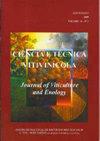圆叶葡萄与葡萄化学多样性的比较。“赤霞珠”
IF 0.9
4区 农林科学
Q4 FOOD SCIENCE & TECHNOLOGY
引用次数: 3
摘要
葡萄藤是世界上最重要的水果植物之一,主要是由于它的葡萄和相关产品,具有高度的经济和文化重要性。每年,葡萄园都会受到几次病原体爆发的影响,控制它们的唯一方法是每12至15天预防性使用农用化学品。这种方法是不可持续的,并不总是有效的。葡萄属包括对病原菌表现出不同水平抗性的不同物种,因此了解这些不同葡萄物种的先天抗性/易感性机制对于应对这些威胁至关重要。在这项工作中,采用非靶向代谢组学方法,利用傅里叶变换-离子回旋共振质谱(FT-ICR-MS)分析了两种葡萄品种:圆形葡萄和葡萄的代谢化学多样性。赤霞珠(Cabernet Sauvignon)(对病原体敏感)。来自两种Vitis的化学式被用于构建Van Krevelen图和组成空间图,这不需要完全的代谢物鉴定,并提供了一种简单的比较方法。仅基于这些可视化工具,就可以发现圆形叶的代谢组比葡萄叶的代谢组更复杂。“赤霞珠”。此外,呈现较高密度的区域与脂质、聚酮和碳水化合物有关。此外,圆叶草代谢组中O/C化合物的比值较高。本文章由计算机程序翻译,如有差异,请以英文原文为准。
Comparison of the chemical diversity of Vitis rotundifolia and Vitis vinifera cv. ‘Cabernet Sauvignon’
Grapevine is one of the most important fruit plants in the world, mainly due to its grapes and related products, with a highly economic and cultural importance. Every year, vineyards are affected by several pathogen outbreaks and the only way to control them is through preventive applications of agrochemicals every 12 to 15 days. This approach is not sustainable and not always effective. The Vitis genus comprise different species that exhibit varying levels of resistance to pathogens, thus the understanding of the innate resistance/susceptibility mechanisms of these different Vitis species is crucial to cope with these threats. In this work, an untargeted metabolomics approach was followed, using Fourier transform-ion cyclotron resonance mass spectrometry (FT-ICR-MS), to analyse the metabolic chemical diversity of two Vitis species: Vitis rotundifolia (resistant to pathogens) and V. vinifera cv. ‘Cabernet Sauvignon’ (susceptible to pathogens). Chemical formulas from both Vitis were used to build Van Krevelen diagrams and compositional space plots, which do not require full metabolite identification and provide an easy comparison method. Based only on these visualization tools, it was shown that the V. rotundifolia metabolome is more complex than the metabolome of V. vinifera cv. ‘Cabernet Sauvignon’. Moreover, the regions that present a higher density are associated to lipids, polyketides and carbohydrates. Also, V. rotundifolia metabolome presented a higher ratio O/C compounds.
求助全文
通过发布文献求助,成功后即可免费获取论文全文。
去求助
来源期刊

Ciencia E Tecnica Vitivinicola
Agricultural and Biological Sciences-Food Science
自引率
12.50%
发文量
5
期刊介绍:
Ciência e Técnica Vitivinícola (Journal of Viticulture and Enology) is an international journal that publishes original articles, research notes and review articles, written in Portuguese or in English, on the various fields of the science and technology of vine and wine: Viticulture, Enology and Vitivinicultural economy.
 求助内容:
求助内容: 应助结果提醒方式:
应助结果提醒方式:


